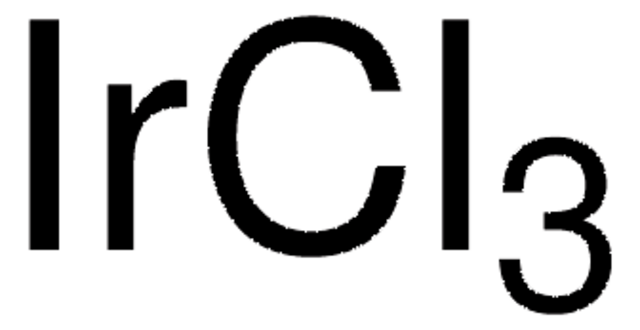450162
Potassium hexachloroiridate(IV)
99.99% trace metals basis
Sinonimo/i:
Iridium potassium chloride
About This Item
Prodotti consigliati
Grado
for analytical purposes
Saggio
99.99% trace metals basis
Stato
powder
Impurezze
≤150.0 ppm Trace Metal Analysis
Punto di fusione
>385 °C (lit.)
Stringa SMILE
[K+].[K+].Cl[Ir--](Cl)(Cl)(Cl)(Cl)Cl
InChI
1S/6ClH.Ir.2K/h6*1H;;;/q;;;;;;+4;2*+1/p-6
WEKZJZDULNNSCD-UHFFFAOYSA-H
Cerchi prodotti simili? Visita Guida al confronto tra prodotti
Applicazioni
- Voltammetry at HMT-PMBI-coated glassy carbon electrodes: This study explores the electrochemical properties of potassium hexachloroiridate(IV) and its potential for sensitive detection, which could be valuable in analytical chemistry applications (M Rees et al., 2020).
- Antioxidant Total Capacity Assay: Introduces a novel assaying method for antioxidant capacity using potassium hexachloroiridate(IV), which could have implications in pharmacology and drug discovery (Y Liu et al., 2024).
- Mass Transfer in 3D-printed Electrolyzers: Examines the role of potassium hexachloroiridate(IV) in enhancing mass transfer in electrolytic systems, which is pivotal for chemical engineering and energy applications (SJC Weusten et al., 2021).
Avvertenze
Warning
Indicazioni di pericolo
Classi di pericolo
Acute Tox. 4 Dermal - Acute Tox. 4 Inhalation - Acute Tox. 4 Oral - Eye Irrit. 2 - Skin Irrit. 2 - STOT SE 3
Organi bersaglio
Respiratory system
Codice della classe di stoccaggio
13 - Non Combustible Solids
Classe di pericolosità dell'acqua (WGK)
WGK 3
Punto d’infiammabilità (°F)
Not applicable
Punto d’infiammabilità (°C)
Not applicable
Dispositivi di protezione individuale
dust mask type N95 (US), Eyeshields, Gloves
Scegli una delle versioni più recenti:
Possiedi già questo prodotto?
I documenti relativi ai prodotti acquistati recentemente sono disponibili nell’Archivio dei documenti.
I clienti hanno visto anche
Il team dei nostri ricercatori vanta grande esperienza in tutte le aree della ricerca quali Life Science, scienza dei materiali, sintesi chimica, cromatografia, discipline analitiche, ecc..
Contatta l'Assistenza Tecnica.










